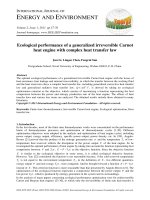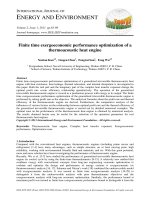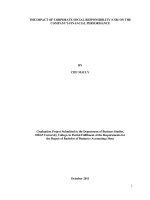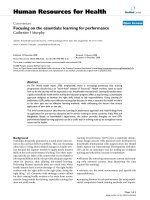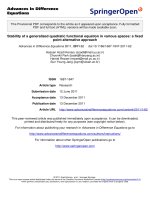Effect of heat transfer law on the finite time exergoeconomic performance of a generalized irreversible carnot heat engine
Bạn đang xem bản rút gọn của tài liệu. Xem và tải ngay bản đầy đủ của tài liệu tại đây (118.12 KB, 10 trang )
INTERNATIONAL JOURNAL OF
ENERGY AND ENVIRONMENT
Volume 5, Issue 5, 2014 pp.601-610
Journal homepage: www.IJEE.IEEFoundation.org
ISSN 2076-2895 (Print), ISSN 2076-2909 (Online) ©2014 International Energy & Environment Foundation. All rights reserved.
Effect of heat transfer law on the finite-time exergoeconomic
performance of a generalized irreversible carnot heat engine
Yi Zhang
1
, Lingeng Chen
2,3,4
, Guozhong Chai
1
1
College of Mechanical Engineering, Zhejiang University of Technology, Hangzhou, 310014, China.
2
Institute of Thermal Science and Power Engineering, Naval University of Engineering, Wuhan 430033,
China.
3
Military Key Laboratory for Naval Ship Power Engineering, Naval University of Engineering, Wuhan
430033, China.
4
College of Power Engineering, Naval University of Engineering, Wuhan 430033, China.
Abstract
The analytical expression for profit rate of a generalized irreversible Carnot heat engine cycle based on a
generalized radiative heat transfer law
)(
n
Tq ∆∝ is derived by applying the finite time exergoeconomic
method, taking into account several additional irreversibilities, such as heat resistance, heat leakage and
other undesirable irreversible factors. The compromise optimization between economics (profit rate) and
the efficiency was obtained by searching the efficiency at maximum profit rate, which is termed as the
finite time exergoeconomic performance bound.
Copyright © 2014 International Energy and Environment Foundation - All rights reserved.
Keywords: Finite-time thermodynamics; Generalized irreversible Carnot heat engine; Exergoeconomic
performance; Generalized thermodynamic optimization; Heat transfer law.
1. Introduction
Recently, the intensive consumption of energy and the exhaustion of resources lead to the rising costs for
energy. Hence, from the economic perspective, improvement of engine performance is urgently required.
Finite-time thermodynamics [1-8] is a powerful tool often used to optimize thermodynamic parameters
including power, efficiency, entropy generation, effectiveness, cooling load, heating load, loss of exergy,
etc.
Nowadays, systems like heat engines are analyzed and designed based on the consideration of both
thermodynamic parameters and cost accounting requirements after the research of Salamon and Nitzan
[9, 10], which was to maximize the profit of an endoreversible heat engine by a combination of a
thermodynamic analysis with an engineer economic analysis. In order to distinguish this method from the
endoreversible analysis optimizing pure thermodynamic objectives, Chen et al. [11-17] analyzed the
profit rate of thermal systems by attributing costs to input and output exergy and termed this method as
finite-time exergoeconomic analysis and its performance bound at maximum profit as finite-time
exergoeconomic performance bound. Other researches seeking for best economic performance of thermal
systems were carried out on endoreversible engines, refrigerators and heat pumps by Ibrahim et al. [18],
De Vos [19, 20] and Bejan [21], with the only irreversibility restricted to the heat transfer between the
working fluid and the heat reservoirs. De Vos [19, 20] applied the Newton (linear) heat transfer law to
International Journal of Energy and Environment (IJEE), Volume 5, Issue 5, 2014, pp.601-610
ISSN 2076-2895 (Print), ISSN 2076-2909 (Online) ©2014 International Energy & Environment Foundation. All rights reserved.
602
derive the relation between the optimal efficiency and economic returns when carrying out
thermoeconomics analysis for heat engine. Chen et al. [22] investigated the endoreversible
thermoeconomic performance of heat engine with the heat transfer between the working fluid and the
heat reservoirs obeying linear phenomenological law. Sahin et al. [23-26] proposed an optimization
criterion considering thermodynamic parameters per unit total cost.
In many pioneer works concerning finite-time exergoeconomic optimization for heat engines, the basic
thermodynamic model is endoreversible. However, a real heat engine will operate in an irreversible
power cycle which incorporates several internal and external irreversibilities, such as heat resistance,
bypass heat leakage, friction, turbulence and other undesirable irreversibility factors. Considering
external and internal irreversibilities, Chen et al. [16-27] established a generalized irreversible Carnot
heat engine model. As heat transfer is not necessarily Newtonian or linear phenomenological, a further
step made in this paper is to establish a fundamental optimal relationship between profit and efficiency of
the generalized irreversible Carnot heat engine based on generalized radiative heat transfer
law
)(
n
Tq ∆∝ . The result obtained by searching the optimum efficiency at maximum profit involved
three common heat transfer laws: Newton’s law (
1
=
n ), the linear phenomenological law ( 1
−
=n ), and
the radiative heat transfer law (
4=n
). The relative studies can be seen in Refs. [28-35].
2. Cycle model and performance analysis
In order to conduct the simulation closer to the performance of an actual heat engine, Chen, et al. [16,
27] established a generalized irreversible steady flow Carnot heat engine cycle model as shown in Figure
1, considering heat resistance, heat leakage, and internal irreversibilities. The working fluid in this
generalized irreversible engine with constant-temperature heat-reservoirs flows steadily. The system
undergoes a cycle which consists of four irreversible processes, two isothermal and two adiabatic.
External irreversibilities are caused by the heat resistance existed in the high- and low-temperature heat-
exchangers. Heat-transfer between the heat engine and its surrounding heat reservoirs leads to the
difference between the working fluid temperature (
HC
T and
LC
T ) and the heat-reservoir temperature
(
H
T and
L
T ). These temperatures are related to one another in the following order:
LLCHCH
TTTT >>> (1)
A constant rate of heat leakage (
q ) from the heat source at the temperature
H
T to the heat sink at
L
T is
assumed for this system, which yields,
qQQ
HCH
+= (2)
qQQ
LCL
+= (3)
where
HC
Q and
LC
Q are the rates of heat-transfer supplied by the heat source and released to the heat
sink by the working fluid, respectively;
H
Q and
L
Q are the real rates of heat-supply and heat-release,
respectively. Assuming the heat-transfer law obeys
)(
n
Tq ∆∝ , the rate of heat leakage can be
expressed as
)(
n
L
n
Hi
TTCq −=
(4)
where
i
C is the heat leakage coefficient.
When analyzing actual heat engines, heat resistance and heat leakage discussed above are not the only
irreversibilities. Irreversibilities caused by friction, turbulence, and non-equilibrium activities inside the
working fluid are also required to be considered. Thus when compared with an endoreversible Carnot
heat engine of the same heat input, the generalized irreversible Carnot engine can deliver less power and
release more heat to the heat sink. Hence, the rate of heat flow (
LC
Q ) to the heat sink for the generalized
International Journal of Energy and Environment (IJEE), Volume 5, Issue 5, 2014, pp.601-610
ISSN 2076-2895 (Print), ISSN 2076-2909 (Online) ©2014 International Energy & Environment Foundation. All rights reserved.
603
irreversible Carnot engine is larger than that (
LC
Q' ) for the endoreversible Carnot engine with the same
input. A constant coefficient (
ϕ
) is introduced in the following expression to generally characterize the
additional miscellaneous irreversible effects
1
'
≥=
LCLC
ϕ
(5)
Application of the second law of thermodynamics yields,
HCHCLCLC
TQTQ =
'
(6)
Combining Eqs. (5) and (6) gives
xQQ
HCLC
ϕ
= (7)
where
LCHC
TTx = (
LH
TTx ≤≤1 ) is the temperature ratio of the working fluid.
Application of the first law of thermodynamics gives the expressions of power output and thermal
efficiency, respectively
LCHCLH
QQQQP −=−= (8)
()
)( qQQQQP
HCLCHCH
+−==
η
(9)
Figure 1. The generalized irreversible Carnot heat engine cycle model
Assuming the rates of the heat flow in the heat-exchangers follow the generalized radiative heat transfer
law,
)(
n
Tq ∆∝ , where n is a heat transfer exponent, with 1
=
n representing the Newton’s law,
1−=n representing the linear phenomenological law and 4
=
n representing the radiative heat transfer
law. Then
International Journal of Energy and Environment (IJEE), Volume 5, Issue 5, 2014, pp.601-610
ISSN 2076-2895 (Print), ISSN 2076-2909 (Online) ©2014 International Energy & Environment Foundation. All rights reserved.
604
)(
11
n
HC
n
HHC
TTFkQ −=
(10)
)(
22
n
L
n
LCLC
TTFkQ −= (11)
where
1
k and
2
k are the overall heat-transfer coefficients of high- and low-temperature side heat-
exchangers,
1
F and
2
F are the surface areas of high- and low-temperature side heat-exchangers. The
total heat transfer surface area of the two heat exchangers is taken as a constant , that is
T
FFF =+
21
(12)
And a ratio (
f ) of heat exchanger area is defined as
21
FFf = (13)
Assuming that the prices of the work output and exergy input are
1
ψ
and
2
ψ
respectively, the profit
rate (profit per unit time) of the generalized irreversible Carnot heat engine is [11]
12
PA
π
ψψ
=−
(14)
where
A is the rate of exergy input of the heat engine which can be expressed as
2100
)1()1(
ε
ε
LHLLHH
QQTTQTTQA
−
=−−−= (15)
where
i
ε
is the Carnot coefficient of the reservoir and
0
T
is the environmental temperature.
Combining Eqs. (2)-(3) and (7)-(15)gives
}])(['{])()[(' qxTTxBxTTxB
n
L
n
H
n
L
n
H
+−−−=
ϕη
(16)
)()]1()1(][)(['
1221221211
εεψψψεϕψψεψπ
−+−−−−= qxxTTB
n
L
n
H
(17)
Where
)])(1[('
211
kkfxxffFkB
n
T
ϕ
++= .
Maximizing
η
and
π
with respect to f by setting 0ddf
η
=
and
0
=
dfd
π
using Eqs. (16) and
(17) yields the same optimal ratio of heat-exchanger area (
opt
f
)
5.0
1
1
2
)]([ kxkff
n
opt
ϕ
−
== (18)
Substituting Eq. (18) into Eqs. (16) and (17), respectively, yields the optimal efficiency and profit rate in
the following forms:
}])([{])()[( qxTTBxxTTxB
n
L
n
H
n
L
n
H
+−−−=
ϕη
(19)
)()]1()1(][)([
1221221211
εεψψψεϕψψεψπ
−+−−−−= qxxTTB
n
L
n
H
(20)
where
25.0
21
5.0
1
])([ kkxxFkB
n
T
ϕ
+= .
Maximum profit rate and maximum efficiency with respect to temperature ratio can be derived by taking
derivatives of Eq.(19) and Eq.(20) with respect to
x
. However, in general, the optimal temperature ratio
International Journal of Energy and Environment (IJEE), Volume 5, Issue 5, 2014, pp.601-610
ISSN 2076-2895 (Print), ISSN 2076-2909 (Online) ©2014 International Energy & Environment Foundation. All rights reserved.
605
x
π
at maximum profit rate
max
π
does not equal to the optimal temperature ratio
x
η
at maximum
efficiency
max
η
. The optimal temperature ratio
x
π
at maximum profit rate
max
π
can be derived by taking
the derivative of the profit rate with temperature ratio and setting it equal to zero (
0=dxd
π
). By
substituting the optimal temperature ratio
x
π
into Eq. (20), the maximum profit rate can be achieved.
Furthermore, the finite-time exergoeconomic bound of the generalized irreversible Carnot heat engine
will be obtained by substituting the optimal temperature ratio
x
π
with respect to maximum profit rate
into Eq. (19).
3. Discussions
3.1 Effects of various losses on the performance
If
1=
ϕ
and 0q > , Eq.(19) and Eq.(20) become
(1)[ ( )]{ [ ( )]}
nn nn
en HL enHL
B
xTxT BxTxT q
η
=−− − +
(21)
)()]1()1(][)([
1221221211
εεψψψεψψεψπ
−+−−−−= qxxTTB
n
L
n
Hen
(22)
where
25.0
21
5.0
1
])([ kkxxFkB
n
Ten
+=
. Eqs. (21) and (22) are the relations between profit rate and
efficiency of the irreversible Carnot heat engine with heat resistance and heat leakage losses.
If
1>
ϕ
and 0=q , Combining Eq.(19) and Eq.(20) gives
1121221
{ [ (1 )] }[(1 ) (1 ) (1 )]
nn
en H L
BTT
π
φψ φ η ε ψ ψ η ε ψ ψ
=−−− −−−
(23)
Eq. (23) is the relation between profit rate and efficiency of the irreversible Carnot heat engine with heat
resistance and internal irreversibility losses.
If
1=
ϕ
and 0=q , Eq. (23) is reduced to
)]1()1()1(}[])1([{
1221211
ψψεηψψεηψπ
−−−−−−=
n
L
n
Hen
TTB
(24)
Eq. (24) is the relation between profit rate and efficiency of the endoreversible Carnot heat engine [11].
3.2 Special cases
(1) Case of
1=n
In the case of
1=n , Eq.(19) and Eq.(20) become:
)())((
11 −−
+−−−= qBxTTTxTx
LHLH
ϕη
(25)
)()]1()1()[(
122122121
1
1
εεψψψεϕψψεψπ
−+−−−−=
−
qxTxTB
LH
(26)
where
25.0
211
])(1[ kkFkB
T
ϕ
+= . Maximizing
π
with respect to
x
by setting
0=dxd
π
in Eq.
(26) yields the optimal temperature ratio and the maximum profit rate of the heat engine:
5.0
211
221
)(
ψεψ
ψεψ
ϕ
−
−
=
L
H
opt
T
T
x
(27)
)(})]([)]({[
122
25.0
221
5.0
211max
εεψψεψϕψεψπ
−+−−−= qTTB
LH
(28)
International Journal of Energy and Environment (IJEE), Volume 5, Issue 5, 2014, pp.601-610
ISSN 2076-2895 (Print), ISSN 2076-2909 (Online) ©2014 International Energy & Environment Foundation. All rights reserved.
606
Substituting Eq. (27) into Eq. (25) gives
π
η
, which is the finite-time exergoeconomic bound of
generalized irreversible Carnot heat engine with Newton’s heat transfer law
15.0
211221
5.0
5.0
211221
5.0
221211
5.0
])()([)(
}])()([])()({[)(
−
+−−−
−−+−−−+
=
qBTTT
TTTT
LHH
LHLH
ψεψψεψϕ
ψεψψεψψεψψεψϕϕ
η
π
(29)
(2) Case of
1−=n
In the case of
1−=n , Eq.(19) and Eq.(20) become
11 11
11
()( )[( )]
LH LH
B
xTxTBxTxTq
ηφ
−− −−
=− − − +
(30)
11
11 1 2 1 22 1 2 2 1
[][(1)(1)]()
LH
BT xTx q
π
ψ εψψ φ εψψ ψε ε
−−
=− − −− +−
(31)
where
0.5 2
11 12
[( )]
T
BkFx kk
φ
=+
. Maximizing
π
with respect to
x
by setting
0=dxd
π
in Eq.
(29) yields the optimal temperature ratio and the maximum profit rate of the heat engine
)1()1()1()(2
)]1()1([)()1(2
121122121
5.0
21
121122
5.0
21122
ψψεψψεφψψεϕ
ψψεψψεφϕψψεφ
−+−+−
−+−+−
=
HLL
HLH
opt
TTkkT
TTkkT
x
(32)
)()]1()1(][[
122122121
11
1max
εεψψψεϕψψεψπ
π
−+−−−−=
−−
qxTxTB
optHoptL
(33)
Substituting Eq. (32) into Eq. (30) gives
π
η
, which is the finite-time exergoeconomic bound of
generalized irreversible Carnot heat engine based on linear phenomenological heat transfer law
]})([{)(
LoptHLHoptopt
TxTBTqTxx −+−=
ππ
ϕη
(34)
where
25.0
211
])([ kkxFkB
optT
ϕ
π
+= .
(3) Case of
4=n
In the case of
4=n , Eq.(19) and Eq.(20) become
}])()[({])()[(
44
4
44
4
qxTTxBxTTxB
LHLH
+−−−=
ϕη
(35)
)()]1()1(][)([
122122121
44
14
εεψψψεϕψψεψπ
−+−−−−= qxxTTB
LH
(36)
where
25.0
21
25.0
14
])([ kkxxFkB
T
ϕ
+= . Eqs (35) and (36) are the relations between profit rate and
efficiency of the irreversible Carnot heat engine based on the radiative heat transfer law.
The relationships between the profit rate and efficiency of the irreversible Carnot heat engine for all
discussed cases are shown in Figure 2 and Figure 3. It can be concluded from the figure that the profit
rate versus efficiency is a loop-shaped curve for all cases with heat leakage. For the cases without heat
leakage, the profit rate decreases when the irreversibility factor
ϕ
increases with the shape of the curve
remaining parabolic. For the case of
0<n , the optimal efficiency at the maximum profit rate increases
with the increase of
n as shown in Figure 2. While, for the case of 0n > , the optimal efficiency at the
maximum profit rate decreases with the increase of
n as shown in Figure 3. When n increases, the
influence of temperature on power becomes more remarkable. Hence, when
n is relatively large, by
slightly sacrificing the efficiency, a significant increase of power can be achieved.
International Journal of Energy and Environment (IJEE), Volume 5, Issue 5, 2014, pp.601-610
ISSN 2076-2895 (Print), ISSN 2076-2909 (Online) ©2014 International Energy & Environment Foundation. All rights reserved.
607
Figure 2. The influences of heat leak, internal irreversibility and heat transfer law on
η
π
−
characteristic for
0n
<
Figure 3. The influences of heat leak, internal irreversibility and heat transfer law on
η
π
−
characteristic for
0n >
3.3 The effect of price ratio
12
ψ
ψ
The finite-time exergoeconomic performance bound at the maximum profit rate is different from the
classical reversible bound and the finite-time thermodynamic bound. It is dependent on
H
T ,
L
T ,
0
T and
12
ψ
ψ
. In order to ensure the process being potential profitable, 10
12
<
<
ψ
ψ
is required.
As the price of work output becomes very large compared with that of exergy input, i.e.,
0
12
→
ψ
ψ
, the
function of the profit rate becomes
International Journal of Energy and Environment (IJEE), Volume 5, Issue 5, 2014, pp.601-610
ISSN 2076-2895 (Print), ISSN 2076-2909 (Online) ©2014 International Energy & Environment Foundation. All rights reserved.
608
PQQxTTxB
LcHc
n
L
n
H 111
)(])()[(
ψψϕψπ
=−=−−=
(37)
The optimization of the profit rate also leads to the maximization of the power output
P of the
generalized irreversible heat engine cycle.
On the other hand, with the price of work output approaching the price of the exergy input, i.e.
1
12
→
ψ
ψ
, the function of the profit rate becomes
σ
ψ
ψ
π
0101
])()([ TTqQTqQT
HHCLLC
−
=
+−+−= (38)
where
σ
is the rate of entropy production of the generalized irreversible heat engine cycle. When
maximizing the profit under this condition, minimization of the losses of exergy can be achieved. Eq.
(38) indicates that the heat engine is always operating at a loss, unless it operates reversibly to reach the
break-even point.
Therefore, for any intermediate values of
12
ψ
ψ
, the finite-time exergoeconomic performance bound
(
π
η
) lies between the finite-time thermodynamic performance bound and the reversible performance
bound.
4. Conclusion
The relationship between the optimal profit rate and efficiency of a generalized irreversible Carnot heat
engine is derived based on generalized radiative heat transfer law. The influence of different heat transfer
laws and irreversibilities on this relationship has been discussed. The results are helpful for establishing a
link among finite-time exergoeconomic performance bound, finite-time thermodynamic performance
bound and the reversible performance bound.
Acknowledgments
This paper is supported by National Natural Science Foundation of China (Project No. 10905093).
References
[1] Andresen, B., Finite-Time Thermodynamics. 1983: University of Copenhagen Copenhagen.
[2]
Bejan, A., Entropy generation minimization: The new thermodynamics of finite-size devices and
finite?time processes. Journal of Applied Physics, 1996, 79(3): p. 1191-1218.
[3]
Chen, L., C. Wu, and F. Sun, Finite time thermodynamic optimization or entropy generation
minimization of energy systems. Journal of Non-Equilibrium Thermodynamics, 1999, 24(4): p.
327-359.
[4]
Berry, R.S., et al., Thermodynamic Optimization of Finite-Time Processes. 2000: Wiley
Chichester.
[5]
Chen, L. and F. Sun, Advances in Finite Time Thermodynamics: Analysis and Optimization.
2004: Nova Publishers.
[6]
Durmayaz, A., et al., Optimization of thermal systems based on finite-time thermodynamics and
thermoeconomics. Progress in Energy and Combustion Science, 2004, 30(2): p. 175-217.
[7]
Andresen, B., Current Trends in Finite-Time Thermodynamics. Angewandte Chemie International
Edition, 2011, 50(12): p. 2690-2704.
[8]
Le Roux, W., T. Bello-Ochende, and J. Meyer, A review on the thermodynamic optimisation and
modelling of the solar thermal Brayton cycle. Renewable and Sustainable Energy Reviews, 2013,
28: p. 677-690.
[9]
Berry, R.S., P. Salamon, and G. Heal, On a relation between economic and thermodynamic
optima. Resources and Energy, 1978, 1(2): p. 125-137.
[10]
Salamon, P. and A. Nitzan, Finite time optimizations of a Newton’s law Carnot cycle. The Journal
of Chemical Physics, 1981, 74: p. 3546.
[11]
Wu, C., L. Chen, and F. Sun, Effect of the heat transfer law on the finite-time, exergoeconomic
performance of heat engines. Energy, 1996, 21(12): p. 1127-1134.
[12]
Chen, L., F. Sun, and C. Wu, Effect of heat transfer law on the performance of a generalized
irreversible Carnot engine. Journal of Physics D: Applied Physics, 1999, 32(2): p. 99.
International Journal of Energy and Environment (IJEE), Volume 5, Issue 5, 2014, pp.601-610
ISSN 2076-2895 (Print), ISSN 2076-2909 (Online) ©2014 International Energy & Environment Foundation. All rights reserved.
609
[13] Chen, L., F. Sun, and C. Wu,, Maximum profit performance of a three heat-reservoir heat pump.
International Journal of Energy Research, 1999, 23(9): p. 773-777.
[14]
Wu, F., et al., Finite-time exergoeconomic performance bound for a quantum Stirling engine.
International Journal of Engineering Science, 2000, 38(2): p. 239-247.
[15]
Chen, L., C. Wu, and F. Sun, Effect of heat transfer law on the finite-time exergoeconomic
performance of a Carnot refrigerator. Exergy, An International Journal, 2001, 1(4): p. 295-302.
[16]
Chen, L., F. Sun, and C. Wu, Maximum-profit performance for generalized irreversible Carnot-
engines. Applied energy, 2004, 79(1): p. 15-25.
[17]
Qin, X., et al., Thermo-economic optimization of an endoreversible four-heat-reservoir absorption-
refrigerator. Applied Energy, 2005, 81(4): p. 420-433.
[18]
Ibrahim, O., S. Klein, and J. Mitchell, Effects of irreversibility and economics on the performance
of a heat engine. Trans. ASME Journal of Solar Energy Engineering, 1992, 114(4) 786-790.
[19]
De Vos, A., Endoreversible thermoeconomics. Energy Conversion and Management, 1995, 36(1):
p. 1-5.
[20]
De Vos, A., Endoreversible economics. Energy Conversion and Management, 1997, 38(4): p. 311-
317.
[21]
Bejan, A., Power and refrigeration plants for minimum heat exchanger inventory. Trans. ASME
Journal of Energy Resources Technology, 1993, 115(2): p. 148-150.
[22]
Chen, L., F. Sun, and C. Wu, Endoreversible thermoeconomics for heat engines. Applied Energy,
2005, 81(4): p. 388-396.
[23]
Sahin, B. and A. Kodal, Finite time thermoeconomic optimization for endoreversible refrigerators
and heat pumps. Energy Conversion and Management, 1999, 40(9): p. 951-960.
[24]
Sahin, B. and A. Kodal, Performance analysis of an endoreversible heat engine based on a new
thermoeconomic optimization criterion. Energy Conversion and Management, 2001, 42(9): p.
1085-1093.
[25]
Sahin, B. and A. Kodal, Thermoeconomic optimization of a two stage combined refrigeration
system: a finite-time approach. International Journal of Refrigeration, 2002, 25(7): p. 872-877.
[26]
Sahin, B., A. Kodal, and A. Koyun, Optimal performance characteristics of a two-stage
irreversible combined refrigeration system under maximum cooling load per unit total cost
conditions. Energy Conversion and Management, 2001, 42(4): p. 451-465.
[27]
Chen, L., F. Sun, and C. Wu, A generalised model of a real heat engine and its performance.
Journal of the Institute of Energy, 1996, 69(481): p. 214-222.
[28]
Feng H, Chen L, Sun F. Finite time exergoeconomic performance optimization for an irreversible
universal steady flow variable-temperature heat reservoir heat pump cycle model. International
Journal of Energy and Environment, 2010, 1(6): 969-986.
[29]
Kan X, Chen L, Sun F, Wu F. Finite time exergoeconomic performance optimization of a
thermoacoustic heat engine. International Journal of Energy and Environment, 2011, 2(1): 85-98.
[30]
Li J, Chen L, Sun F. Finite-time exergoeconomic performance of an endoreversible Carnot heat
engine with complex heat transfer law. International Journal of Energy and Environment, 2011,
2(1): 171-178.
[31]
Chen L, Yang B, Sun F. Exergoeconomic performance optimization of an endoreversible
intercooled regenerated Brayton cogeneration plant. Part 1: thermodynamic model and parameter
analyses. International Journal of Energy and Environment, 2011, 2(2): 199-210
[32]
Yang B, Chen L, Sun F. Exergoeconomic performance optimization of an endoreversible
intercooled regenerated Brayton cogeneration plant. Part 2: heat conductance allocation and
pressure ratio optimization. International Journal of Energy and Environment, 2011, 2(2): 211-218.
[33]
Chen L, Kan X, Wu F, Sun F. Finite time exergoeconomic performance optimization of a
thermoacoustic cooler with a complex heat transfer exponent. International Journal of Energy and
Environment, 2012, 3(1): 19-32.
[34]
Yang B, Chen L, Sun F. Exergoeconomic performance optimization of an endoreversible
intercooled regenerative Brayton combined heat and power plant coupled to variable- temperature
heat reservoirs. International Journal of Energy and Environment, 2012, 3(4): 505-520.
[35]
Chen L, Kan X, Sun F, Wu F. Exergoeconomic performance optimization for a steady-flow
endoreversible refrigerator model including six typical cycles. International Journal of Energy and
Environment, 2013, 4(1): 93-102.
International Journal of Energy and Environment (IJEE), Volume 5, Issue 5, 2014, pp.601-610
ISSN 2076-2895 (Print), ISSN 2076-2909 (Online) ©2014 International Energy & Environment Foundation. All rights reserved.
610
Yi Zhang is currently pursuing his PhD in Zhejiang University of Technology, P R China. He receive
d
his BS Degree in 2009 and MS Degree in 2010 in Electromechanical Engineering from Group T-
International University College, Belgium. His work covers topics in finite time thermodynamics fo
r
Carnot and Brayton cycles.
Lingeng Chen received all his degrees (BS, 1983; MS, 1986, PhD, 1998) in power engineering an
d
engineering thermophysics from the Naval University of Engineering, P R China. His work covers a
diversity of topics in engineering thermodynamics, constructal theory, turbomachinery, reliability
engineering, and technology support for propulsion plants. He had been the Director of the Department
of Nuclear Energy Science and Engineering, the Superintendent of the Postgraduate School, and the
President of the College of Naval Architecture and Power. Now, he is the Direct, Institute of Thermal
Science and Power Engineering, the Director, Military Key Laboratory for Naval Ship Powe
r
Engineering, and the President of the College of Power Engineering, Naval University of Engineering,
P R China. Professor Chen is the author or co-author of over 1400 peer-refereed articles (over 620 in
English journals) and nine books (two in English).
E-mail address: ; , Fax: 0086-27-83638709 Tel: 0086-27-83615046.
Guozhong Chai received his BS Degree in 1982 and MS Degree in 1984 in Chemical Process
Machinery from Zhejiang University of Technology, P R China, and received his PhD Degree in 1994
in Chemical Process Machinery from East China University of Science and Technology, P R China. His
work covers topics in computational mechanics, fracture and damage mechanics and their engineering
applications. He has been the Dean of the College of Mechanical Engineering, Zhejiang University o
f
Technology, P R China. Now he is the Dean of the Faculty of Engineering II, Zhejiang University o
f
Technology, P R China. Professor Chai is the author or co-author of over 126 peer-refereed papers.


